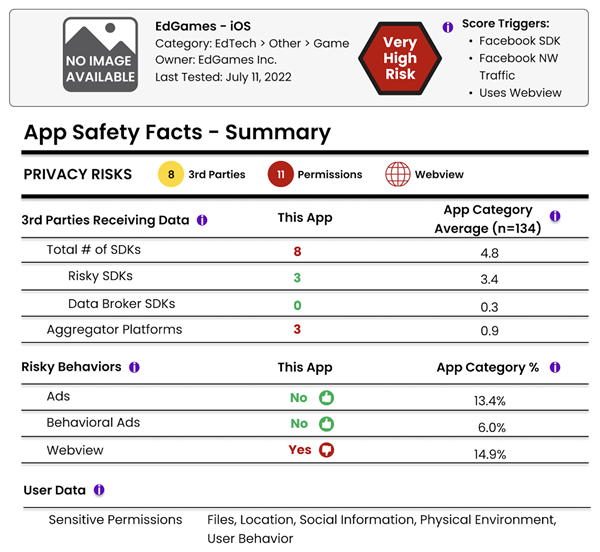Internet Safety Labs is on a mission to ensure safety and human dignity in connected products and services. We measure the behavior of technology to catalyze product teams, policymakers, and researchers to take action.
My Role
My role at Internet Safety Labs is twofold: As, l developed research operations to provide user experience and other research services to the various working groups, exploring questions around the consumer experience of their relationship with digital technology.
Secondly, I developed the product integrity testing framework (UX audit) for digital technologies, in particular mobile apps and websites. This framework, based on information architecture heuristics and coupled with data integrity and security testing, makes up the requirements for ISL Safe Software Specification.
In 2023, I continued working with ISL as a consulting researcher. I recently completed an Internet Society-funded study of consumer perceptions of safety testing of internet-connected products. We published the final research report, Consumer Attitudes Towards Product Safety: Physical Consumer Goods vs. Internet Connected Products, on March 6, 2024.
I am currently consulting on a 2025-2026 Internet Society funded project to develop a dark patterns audit framework for web and mobile apps.
This work is a continuation of my contract with ISL’s original name, the Me2B Alliance.
Methods
Product Integrity Testing
I developed the UX Integrity framework for the ISL Safe Software Specification, a new version of the Me2B Safe Technology Specification, where I also consulted on a product integrity framework. I based the framework on an application of Abby Covert’s Information Architecture Heuristics to ensure that notices of data collection, use and sharing is Clear, Findable, Accessible, Credible and Communicative, or understandable by a wide audience of human and machine readable or accessible devices. Harry Brignull’s Deceptive.Design taxonomy, further developed by Purdue University’s UXP2 Lab, also proved helpful in classifying potential harms in software. I trained a research staff member and a developer on how to perform the UX audit for safe software.
Building on this work, in 2025 I began developing a dark patterns audit framework identifying harmful UI patterns contributing to digital harm as defined by the U.S. Federal Trade Commission. These patterns include user interfaces and information omissions that present the following risks:
- Design elements that induce false beliefs
- Design elements that hide or delay disclosure of material information
- Design elements that lead to unauthorized charges
- Design elements that obscure or subvert privacy choices
I am working with an ISL audit team to implement a dark patterns testing process that will be included in the AppMicroscope Safety Label.
Data Privacy Audit
I conducted a study of several usability testing and survey packages, using the ISL framework, to understand how these software programs collect, store and whether they share participant data with third parties. I presented my findings in a lightning talk on informed consent at the 2022 Symposium on Usable Privacy and Security.
Qualitative and Quantitative Research
I conducted interviews, focus groups and surveys to discover attitudes and behaviors related to the safety of software and software-enabled products. I documented insights from two focus groups of technology consumers on technology relationships, privacy policies and terms of use. I developed several surveys to further explore insights from qualitative research to understand whether the attitudes discovered in interviews were widely held. The research helped to evolve our understanding of how consumers experience their relationship and risks with respect to digital technologies. I also interviewed and surveyed product developers to discover their attitudes and procedures for product safety.
Sample research questions:
How do people describe their relationship with technology?
Under what conditions is it acceptable for a website or mobile app to know one’s location?
Do people change how they interact with a website when they are familiar with the legal terms of the website? Do they understand who and what these policies protect?
Do people want the ability to send their own legally binding Information Service Agreement to service providers? Do they want (and would they use) a data management dashboard for managing the personal information that gets shared with all service providers?
Information Visualization
ISL’s App Microscope provides an overview of internet safety of downloadable mobile apps. I provided consulting on the visual and information design of the App Microscope safety label, including labeling, tool tips and language for the component definitions.

Tools
Usability Software: SurveyMonkey, Prolific.io, Optimal Workshop, Usertesting.com, Userinterviews.com
Survey Software: SurveyMonkey, Google Forms, Microsoft Forms, Typepad
Collaboration: Microsoft Teams, Zoom, Sharepoint, Excel, OneNote, Trello, Monday
Research Artifacts
Published Reports
Consumer Attitudes Towards Product Safety: Physical Consumer Goods vs. Internet Connected Products. (March 5, 2024). Internet Safety Labs.
Spotlight Report #6: Proffering Machine-Readable Personal Privacy Research Agreements: Pilot Project Findings for IEEE P7012 WG. (June 2, 2022). Internet Safety Labs.
Spotlight Report #5: Me2B Alliance Validation Testing Report: Consumer Perception of Legal Policies in Digital Technology. (January 18, 2022). Internet Safety Labs.
Spotlight Report #3: Me2B Alliance Validation Research: Consumer Sensitivity to Location Tracking by Websites and Mobile Apps (November 5, 2021). Internet Safety Labs.
Software Specifications
ISL Safe Software Specification for Websites and Mobile Apps V1.1. (July 5, 2022). Internet Safety Labs.
Me2B Safe Specification v1.0. (April 29, 2020). Internet Safety Labs.
Presentations
Preventing Digital Harm in Online Spaces (May 26, 2023). UX LX: UX Lisbon.
Informed Consent: Are Your Participants Aware of What They Share? (August 7-9, 2022). SOUPS2022: Symposium on Usable Privacy and Security. USENIX.
Statement on Dark Patterns at the California Privacy Protection Agency Stakeholders Meeting. (May 5, 2022). Internet Safety Labs.
Safe Tech Audit: IA as a Framework for Respectful Design (April 23, 2022). IAC22: Information Architecture Conference.
The Future of the Metaverse with Vint Cerf and Noreen Whysel. (April 12, 2022). Disruptive Technologists.
Shedding Light on Dark Patterns: A Case Study on Digital Harms. (April 28, 2021).
IAC21: Information Architecture Conference.
Webinar: Me2B Research: Consumer Views on Respectful Technology. (January 28, 2021). Internet Safety Labs.
Future Plans
Internet Safety Labs is seeking grant funding to continue its mission to keep tech safe. Visit at https://www.internetsafetylabs.org.
More research projects
Identity Ecosystem Framework Registry
